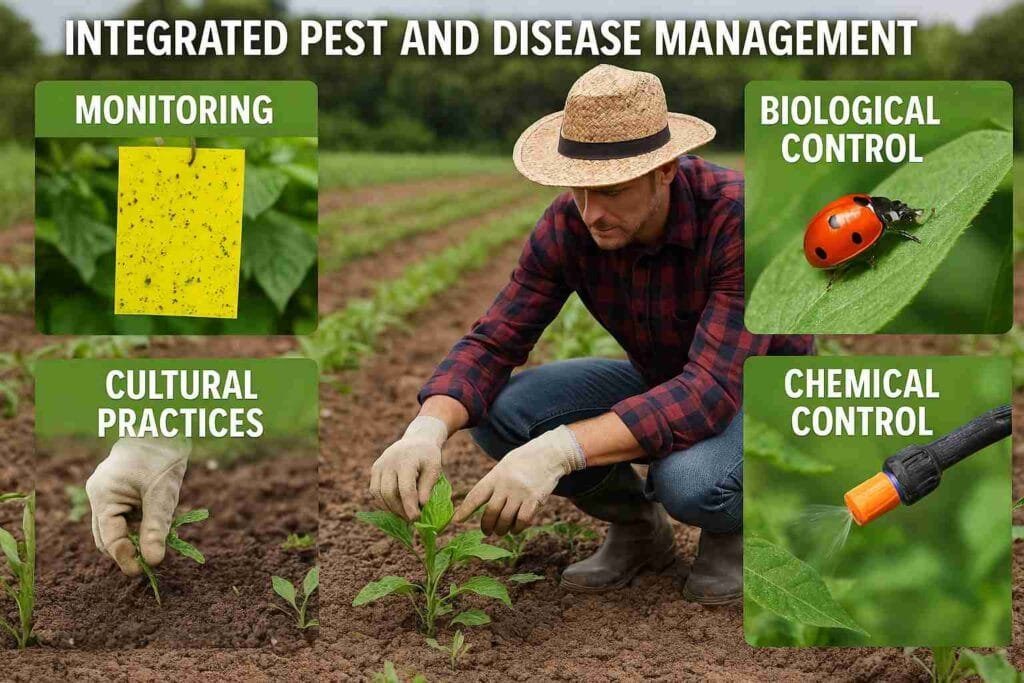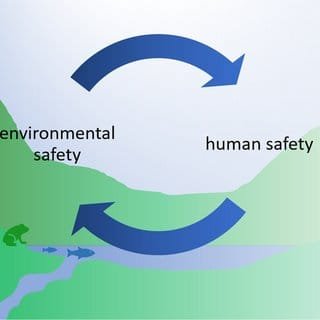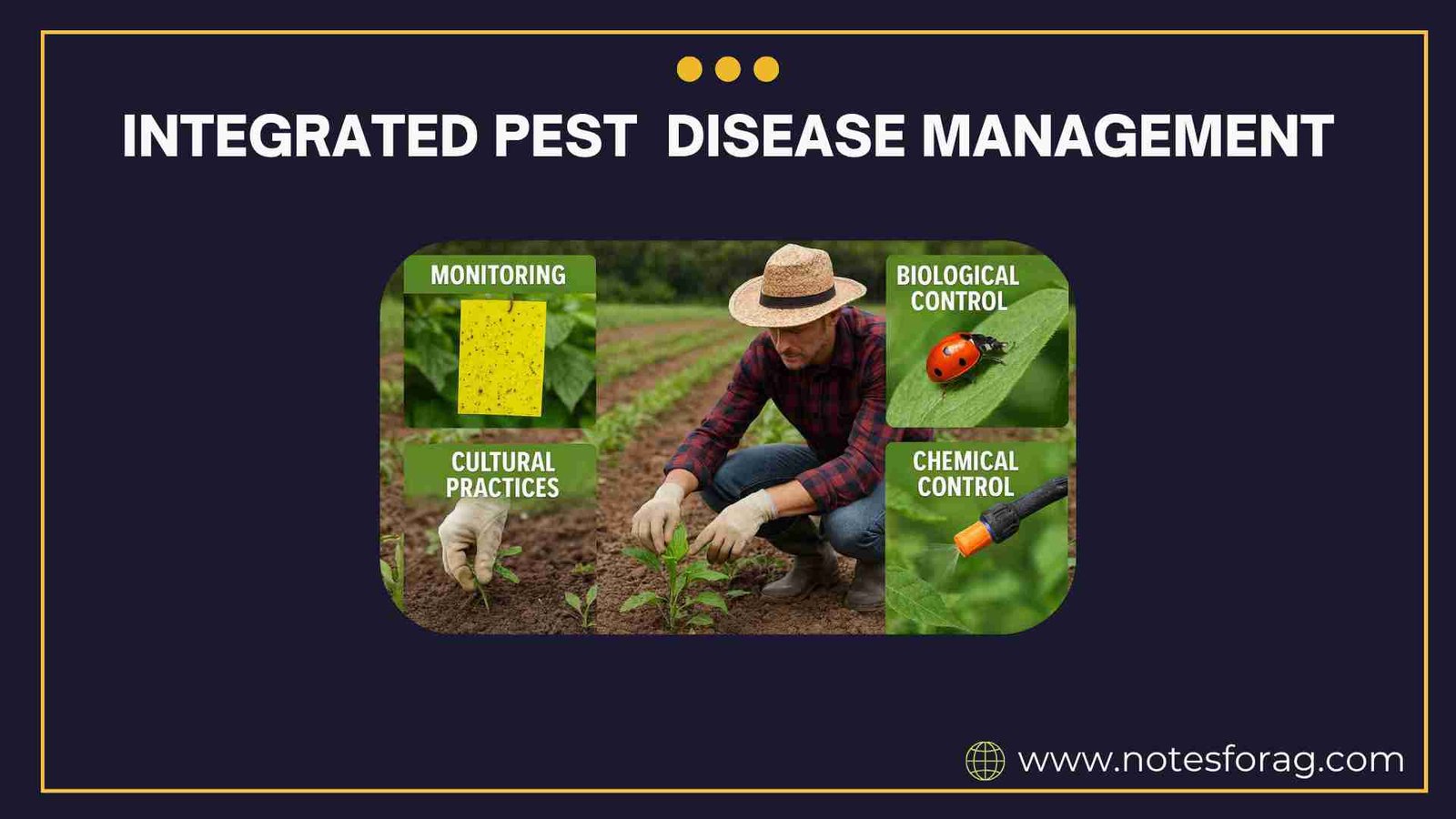Introduction to IPDM

Integrated Pest and Disease Management (IPDM) is a holistic approach to managing pests and diseases that affect crops. Unlike conventional pest control methods that rely heavily on chemical pesticides, IPDM combines a range of biological, cultural, physical, and chemical tools to reduce pest populations and disease incidence to economically manageable levels. The primary goal of IPDM is not complete eradication but rather effective control that is environmentally sustainable, economically viable, and socially acceptable.
Summary of IPDM
- Integrated Pest and Disease Management focuses on proactive prevention through crop rotation, resistant varieties, and regular monitoring.
- Control measures are applied only when pest levels exceed economic thresholds.
- A strategic mix of cultural, biological, mechanical, and minimal chemical methods is used to ensure effective, sustainable crop protection.
Table of Contents
Key Principles of IPDM
1. Prevention and Suppression
Preventing pests and diseases from becoming a threat is the first and most effective line of defense in IPDM. This involves the use of resistant crop varieties, maintaining healthy soil through organic matter and crop rotation, proper sanitation of fields and tools, and timely sowing. These preventive measures create unfavorable conditions for pests and diseases, reducing the chances of outbreaks. Suppression involves actions like pruning infected plant parts, using biological agents, or implementing physical barriers to reduce the existing population below damaging levels.
2. Monitoring and Early Detection
Regular monitoring of crops for signs of pests and diseases is essential in IPDM. This includes visual inspection, use of traps (like pheromone or sticky traps), and field surveys. Early detection helps farmers take timely action before the infestation reaches economically damaging levels. Monitoring also aids in understanding pest life cycles, behavior, and environmental conditions that favor their proliferation.
3. Decision Making Based on Threshold Levels
A critical component of IPDM is the use of economic threshold levels, which is the pest population level at which control measures should be implemented to prevent unacceptable damage or economic loss. Instead of reacting to every pest sighting, decisions are made based on scientific assessments and damage thresholds, which prevents unnecessary pesticide applications and promotes cost-effective management.
4. Use of Multiple Control Methods
IPDM emphasizes the combination of several control techniques rather than relying on a single method. These include:
- Biological control: Using natural predators, parasites, or pathogens to manage pest populations.
- Cultural control: Practices like crop rotation, intercropping, and choosing the right planting time.
- Mechanical and physical control: Techniques such as handpicking pests, using traps, and installing barriers.
- Chemical control: Judicious use of pesticides when necessary, focusing on targeted, safe, and minimal usage.
The integrated use of these methods reduces the risk of pests developing resistance and minimizes negative impacts on non-target organisms and the environment.
5. Pesticide Resistance Management
Over-reliance on chemical pesticides can lead to resistance in pest populations. IPDM tackles this issue by rotating pesticides with different modes of action, limiting the use of broad-spectrum chemicals, and applying chemicals only when needed. This approach helps maintain the effectiveness of available pesticides and reduces the likelihood of resistance development.
6. Environmental and Human Safety

IPDM prioritizes practices that are safe for the environment, farmers, and consumers. Chemical usage is minimized to avoid pollution of soil, water, and air, and to protect beneficial organisms such as pollinators and natural enemies. Protective equipment and safety guidelines are emphasized during chemical application to ensure human health is not compromised.
7. Education and Farmer Participation
The success of IPDM depends greatly on farmer awareness, education, and participation. Farmers must understand pest biology, monitoring techniques, threshold levels, and various control options. Capacity-building through training programs, workshops, and extension services enables farmers to make informed decisions and apply IPDM principles effectively on their farms.
8. Record Keeping and Evaluation
Maintaining records of pest incidences, weather conditions, crop health, and management actions is crucial for the ongoing success of IPDM. Evaluation of results allows for adjustments in strategies, ensuring continuous improvement in pest and disease management practices. Data-driven decision-making enhances accuracy, efficiency, and sustainability.
Implementation Strategies of IPDM
Planning and Field Assessment
Before implementing IPDM, a comprehensive assessment of the field, crop history, and pest pressure is necessary. This helps identify potential risks and select appropriate control measures tailored to the specific field conditions.
Community-Based Approaches
Pests and diseases often affect entire regions rather than individual fields. Hence, coordinated efforts among neighboring farms can lead to more effective management. Community-wide IPDM practices help prevent pest migration and build collective resilience.
Use of Technology and Innovations

Modern tools like GPS mapping, drone surveillance, mobile apps, and AI-driven forecasting models assist in timely pest identification and decision-making. These innovations enhance precision and enable proactive interventions, reducing crop losses.
Government Policies and Support
Policies supporting IPDM through subsidies, research funding, and awareness campaigns are vital for widespread adoption. Extension services, access to quality biocontrol agents, and regulation of pesticide use also play key roles.
Benefits of Integrated Pest and Disease Management
IPDM offers a range of benefits including improved crop yield and quality, reduced pesticide costs, protection of biodiversity, enhanced soil and water health, and better market access for produce due to minimal chemical residues. It supports long-term sustainability and aligns with environmental protection goals.
Challenges in Adopting IPDM
Despite its benefits, challenges like limited farmer knowledge, lack of access to biological control agents, poor infrastructure, and weak policy enforcement can hinder adoption. Addressing these requires collaboration among governments, researchers, NGOs, and farmer organizations.
Conclusion
Integrated Pest and Disease Management (IPDM/IPM) represents a balanced and sustainable approach to crop protection, rooted in ecological principles and scientific rigor. At its core, IPDM prioritizes prevention implementing practices like resistant cultivars, crop rotation, field sanitation, and proper planting schedules that create unfavorable conditions for pests and diseases. This preventative mindset is complemented by ongoing monitoring and early detection through field inspections, trapping, and weather-based forecasting, which enable timely and informed management decisions. By relying on action thresholds, farmers avoid unnecessary interventions and focus only on pest levels that threaten economic viability.
When intervention is necessary, IPDM emphasizes deploying the least harmful control methods first such as physical removal, barriers, or introducing natural predators ensuring ecological balance while minimizing adverse impacts. Chemical pesticides are reserved for critical situations and applied judiciously through targeted, resistance-conscious strategies that rotate active ingredients to maintain their long-term effectiveness.
A standout strength of IPDM lies in its integration of multiple tactics cultural, biological, physical, and chemical which reduces reliance on any single method and lowers the risk of pest resistance while safeguarding beneficial organisms. Regular record-keeping and evaluation help refine practices over time, fostering continuous improvement and adaptability. Beyond individual fields, community-wide coordination, supported by policy frameworks, extension services, and farmer education, amplifies the efficacy of IPDM and promotes regional resilience.
However, successful adoption of IPDM requires technical knowledge, access to biocontrol agents, and sometimes upfront labor investment challenges that can be overcome through better infrastructure, training, and institutional support.
In sum, IPDM transforms pest and disease control into a smart, eco-conscious, and economically sound practice. Rather than aiming for eradication, its goal is to manage pest populations in harmony with the ecosystem. By integrating diverse tactics and prioritizing environmental safety, IPDM equips farmers to produce healthier crops, reduce chemical inputs, and strengthen agricultural sustainability establishing a resilient foundation for future food systems.
Frequently Asked Questions (FAQs)
What is action threshold in integrated pest management?
An action threshold is the specific pest population level at which control measures should be applied. It helps avoid unnecessary treatments and ensures timely, cost-effective interventions.
How does biological control work in IPM?
Biological control works by using natural enemies like predators, parasites, or pathogens to manage pest populations. This method is safe, sustainable, and environmentally friendly.
How often should crops be monitored in IPDM?
Crops should be monitored regularly, ideally once a week or during critical growth stages. Monitoring frequency may vary depending on pest pressure and environmental conditions.
Related Articles

